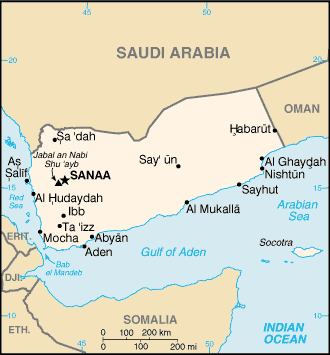Yemen

The Republic of Yemen is a country in the Arabian Peninsula in Southwest Asia, and is a part of the Middle East, bordering the Arabian Sea, Gulf of Aden, and Red Sea, between Oman and Saudi Arabia. Yemen was one of the oldest centers of civilization in the Near East. Between the 9th century BC and the 6th century AD, it was part of the Minaean, Sabaean, Himyarite, Qatabanian, Hadhramawtian, and Awsanian kingdoms, which controlled the lucrative spice trade. It was known to the Romans as "Arabia Felix" ("Happy Arabia") because of the riches its trade generated; Augustus Caesar attempted to annex it, but the expedition failed. In the 7th century, Islamic caliphs began to exert control over the area. After this caliphate broke up, the former north Yemen came under control of Imams of various dynasties usually of the Zaidi sect, who established a theocratic political structure that survived until modern times. (Imam is a religious term. The Shiites apply it to the prophet Muhammad's son-in-law Ali, his sons Hassan and Hussein, and subsequent lineal descendants, whom they consider to have been divinely ordained unclassified successors of the prophet.) North Yemen became independent of the Ottoman Empire in 1918. The British, who had set up a protective area around the southern port of Aden in the 19th century, withdrew in 1967 from what became South Yemen. In 1970, the southern government adopted a Communist governmental system. The leaving of hundreds of thousands of Yemenis from the south to the north contributed to two decades of hostility between the states. The two countries were formally united as the Republic of Yemen on May 22, 1990. A southern movement which tried to withdraw from the Republic in 1994 was quickly subdued.
British influence increased among the traditional sultanates in the south and eastern portion of Yemen, historically known as the Hadhramaut after the British captured the port of Aden in 1839. It was ruled as part of British India until 1937, when Aden was made a crown colony with the remaining land designated as east Aden and west Aden protectorates. By 1965, most of the tribal states within the protectorates and the Aden colony proper had joined to form the British-sponsored Federation of South Arabia. In November 1989, the leaders of the YAR (Ali Abdullah Saleh) and the PDRY (Ali Salim al-Baidh) agreed on a draft unity constitution originally drawn up in 1981. The Republic of Yemen (ROY) was declared on May 22, 1990. Saleh became President, and al-Baidh became Vice President. A unity constitution was agreed upon in May 1990 and ratified by the populace in May 1991. It affirmed Yemen's commitment to free elections, a multiparty political system, the right to own private property, equality under the law, and respect of basic human rights. Haydar Abu Bakr Al-Attas (former southern Prime Minister) continued to serve as the ROY Prime Minister, but his government was ineffective due to political infighting. Continuous negotiations between northern and southern leaders resulted in the signing of the document of pledge and accord in Amman, Jordan on February 20, 1994. Despite this, clashes intensified until civil war broke out in early May 1994. Almost all of the actual fighting in the 1994 civil war occurred in the southern part of the country despite air and missile attacks against cities and major installations in the north. Southerners sought support from neighboring states and received billions of dollars of equipment and financial assistance, mostly from Saudi Arabia, which felt threatened by a united Yemen. The United States strongly supported Yemeni unity, but repeatedly called for a cease-fire and a return to the negotiating table. Various attempts, including by a UN special envoy, were unsuccessful to effect a cease-fire. An armed opposition was announced from Saudi Arabia, but no significant incidents within Yemen materialized. The government prepared legal cases against four southern leaders--Ali Salim Al-Bidh, Haydar Abu Bakr Al-Attas, Abd Al-Rahman Ali Al-Jifri, and Salih Munassar Al-Siyali--for misappropriation of official funds. Others on the list of 16 were told informally they could return to take advantageof the amnesty, but most remained outside Yemen. Although many of Ali Nasir Muhammad's followers were appointed to senior governmental positions (including Vice President, Chief of Staff, and Governor of Aden), Ali Nasir Muhammad himself remained abroad in Syria. In the aftermath of the civil war, YSP leaders within Yemen reorganized the party and elected a new politburo in July 1994. However, the party remained disheartened and without its former influence. Islaah held a party convention in September 1994. The GPC did the same in June 1995. In 1994, amendments to the unity constitution eliminated the presidential council. President Ali Abdallah Salih was elected by Parliament on October 1, 1994 to a 5-year term. The constitution provides that henceforth the President will be elected by popular vote from at least two candidates selected by the legislature. Yemen held its first direct presidential elections in September 1999, electing President Ali Abdallah Salih to a 5-year term in what were generally considered free and fair elections. Yemen held its second multiparty parliamentary elections in April 1997. Since 2000, the government has been fighting rebel groups, such as led by Hussein al-Houthi. On October 12, 2000, the USS Cole - an American guided missile destroyer - was attacked by waterborne terrorists as the American ship was refueling in the port of Yemen. Two suicide bombers approached the Cole in a small boat loaded with explosives. Once alongside the ship, the men detonated the explosives, killing themselves and 17 American sailors. Click here to go back to the Middle East Page! This article is licensed under the GNU Free Documentation License. It uses material from the Wikipedia article "Yemen". |
|||||||||||